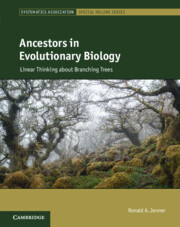Book contents
- Ancestors in Evolutionary Biology
- The Systematics Association Special Volume Series
- Ancestors in Evolutionary Biology
- Copyright page
- Dedication
- Contents
- Acknowledgments
- 1 A History of Narrative Phylogenetics
- 2 From Archetypes to Ancestors
- 3 The Emergence of Lineage Thinking
- 4 Ernst Haeckel’s Evolutionary Storytelling
- 5 The Epistemic Rise of Hypothetical Ancestors
- 6 Intuiting Evolution
- 7 Telling Straight Stories with Fossils
- 8 Seeing Animal Ancestors in Embryos
- 9 Ancestral Attractions and Phylogenetic Folklore
- 10 Narrative Shortcuts and Phylogenetic Faux Pas
- 11 Taxic Distortions of Lineage Thinking
- 12 Making Sense with Stories
- References
- Index
- Systematics Association Special Volumes
4 - Ernst Haeckel’s Evolutionary Storytelling
Published online by Cambridge University Press: 08 July 2022
- Ancestors in Evolutionary Biology
- The Systematics Association Special Volume Series
- Ancestors in Evolutionary Biology
- Copyright page
- Dedication
- Contents
- Acknowledgments
- 1 A History of Narrative Phylogenetics
- 2 From Archetypes to Ancestors
- 3 The Emergence of Lineage Thinking
- 4 Ernst Haeckel’s Evolutionary Storytelling
- 5 The Epistemic Rise of Hypothetical Ancestors
- 6 Intuiting Evolution
- 7 Telling Straight Stories with Fossils
- 8 Seeing Animal Ancestors in Embryos
- 9 Ancestral Attractions and Phylogenetic Folklore
- 10 Narrative Shortcuts and Phylogenetic Faux Pas
- 11 Taxic Distortions of Lineage Thinking
- 12 Making Sense with Stories
- References
- Index
- Systematics Association Special Volumes
Summary
In this chapter I take a detailed look at the evolutionary storytelling of Ernst Haeckel. He founded phylogenetics as the science dedicated to tracing the evolution of lineages. Although Haeckel’s phylogenetic scenarios were nourished from a broad buffet of evidence, the biogenetic law was his favorite shortcut to create lineages of hypothetical ancestors, most famously the tiny cup-shaped Gastraea. A recent consensus has emerged that stigmatizes Haeckel’s phylogenies as unDarwinian constructs that are conceptually stained by teleological thinking and the linearity of the scala naturae. Instead, I argue that his trees are fully Darwinian, and that the linearity present in his trees and thinking is the linearity of evolving lineages that track the arrow of time. Lineage thinking was novel when Haeckel started writing, and his was marred by imperfections. It was up to the following generations of evolutionists to resolve the conceptual tension between the linear and branching aspects of evolution, a struggle that is still ongoing in today’s literature.
Keywords
- Type
- Chapter
- Information
- Ancestors in Evolutionary BiologyLinear Thinking about Branching Trees, pp. 86 - 121Publisher: Cambridge University PressPrint publication year: 2022

